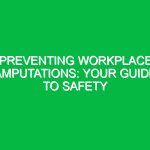Understanding Control Risks in the HSE Domain
Control risks encompass the potential hazards that arise from inadequate management of health, safety, and environmental (HSE) practices. These risks can lead to severe consequences, including workplace accidents, environmental damage, and legal repercussions. In today’s fast-paced industrial landscape, the importance of controlling these risks cannot be overstated. Organizations that prioritize effective risk management not only safeguard their employees and the environment but also enhance their operational efficiency and reputation.
Imagine a construction site where safety protocols are overlooked. Workers may face exposure to hazardous materials, heavy machinery, or unsafe conditions. The repercussions of such negligence can be catastrophic, leading to injuries, fatalities, and costly legal battles. This example highlights the critical nature of control risks within the HSE framework, serving as a clarion call for businesses to adopt robust risk management strategies.
Key Aspects of Control Risks in HSE
1. Identifying Potential Hazards
The first step in managing control risks is identifying potential hazards. This process involves recognizing anything that could cause harm to employees, the public, or the environment. Hazards can be classified into various categories, including:
- Physical Hazards: These include machinery, electrical equipment, and working at heights.
- Chemical Hazards: Exposure to toxic substances, flammable materials, and corrosive chemicals.
- Biological Hazards: Risks associated with exposure to bacteria, viruses, and other pathogens.
- Ergonomic Hazards: These arise from poor workplace design and practices that can lead to musculoskeletal injuries.
Conducting thorough risk assessments is essential in this phase. Employers should engage employees in discussions about their experiences and observations regarding potential risks. This collaborative approach not only enhances the identification process but also fosters a culture of safety within the organization.
2. Risk Assessment and Evaluation
Once hazards are identified, the next critical step is to assess and evaluate the associated risks. This process involves determining the likelihood of an incident occurring and the severity of its consequences. Various methods can be employed for this evaluation, including:
- Qualitative Risk Assessment: This method uses descriptive scales to gauge risks based on expert judgment.
- Quantitative Risk Assessment: This approach involves numerical data to calculate risk probabilities and impacts.
- Bow-Tie Analysis: This visual tool illustrates the pathways from hazards to outcomes, highlighting preventive and mitigating measures.
By meticulously analyzing risks, organizations can prioritize their efforts and resources toward the most significant threats, ensuring a more effective allocation of safety measures.
3. Implementing Control Measures
After evaluating risks, it is time to implement control measures designed to mitigate identified threats. Control measures can be classified into three categories:
- Engineering Controls: These involve physical changes to the workplace, such as installing safety guards on machinery or improving ventilation systems.
- Administrative Controls: These encompass changes in work policies or procedures to reduce risk, such as implementing safety training programs or revising work schedules.
- Personal Protective Equipment (PPE): When hazards cannot be eliminated, providing appropriate PPE, such as helmets, gloves, and respiratory protection, becomes crucial.
For instance, a manufacturing company identified a risk of noise-induced hearing loss among its workers. In response, they implemented engineering controls by installing sound barriers and administrative controls by enforcing mandatory hearing conservation training. Such proactive measures demonstrate a commitment to employee safety and well-being.
4. Monitoring and Review
Implementing control measures is not the end of the journey; continuous monitoring and review are essential for maintaining HSE success. Regular audits, inspections, and employee feedback mechanisms help organizations ensure that control measures remain effective and relevant. Moreover, any changes in operations, technology, or regulations should trigger a reassessment of existing control risks.
In my experience working with a logistics firm, we established a quarterly review process that involved cross-departmental teams. This collaborative approach led to the discovery of new risks and the enhancement of existing control measures, fostering an ongoing culture of safety improvement.
5. Training and Awareness
Education and awareness are critical components of managing control risks. Organizations must invest in training programs that empower employees to recognize hazards and understand the importance of following safety protocols. Training should be tailored to the specific needs of each workplace and should include both theoretical knowledge and practical exercises.
For example, a construction company might conduct regular safety drills to prepare workers for emergency situations. These simulated scenarios allow employees to practice their responses, fostering confidence and competence in real-life situations. Furthermore, promoting a culture of open communication encourages employees to voice safety concerns without fear of retribution.
Regulations and Standards Governing Control Risks
Control risks in the HSE context are heavily influenced by various regulations and standards. These legal frameworks establish minimum safety requirements and outline the responsibilities of employers and employees. Some key regulations include:
- Occupational Safety and Health Administration (OSHA) Standards: In the United States, OSHA sets forth regulations that govern workplace safety, outlining employers’ responsibilities to protect workers from hazards.
- Environmental Protection Agency (EPA) Regulations: The EPA establishes standards for environmental protection, ensuring that businesses manage their operations in an environmentally responsible manner.
- ISO 45001: This international standard provides a framework for occupational health and safety management systems, promoting proactive risk management.
Compliance with these regulations not only helps organizations avoid legal repercussions but also fosters a culture of safety and responsibility.
Conclusion
In summary, control risks play a pivotal role in the health, safety, and environmental domain. By identifying potential hazards, assessing risks, implementing control measures, and fostering a culture of safety through training and awareness, organizations can achieve HSE success. Moreover, adherence to relevant regulations and standards reinforces the importance of responsible risk management.
As industries continue to evolve and face new challenges, it is imperative that organizations remain vigilant in their approach to control risks. By doing so, they not only protect their employees and the environment but also enhance their overall operational effectiveness and reputation. The path to successful HSE management is a continuous journey, one that requires commitment, collaboration, and a proactive mindset.


